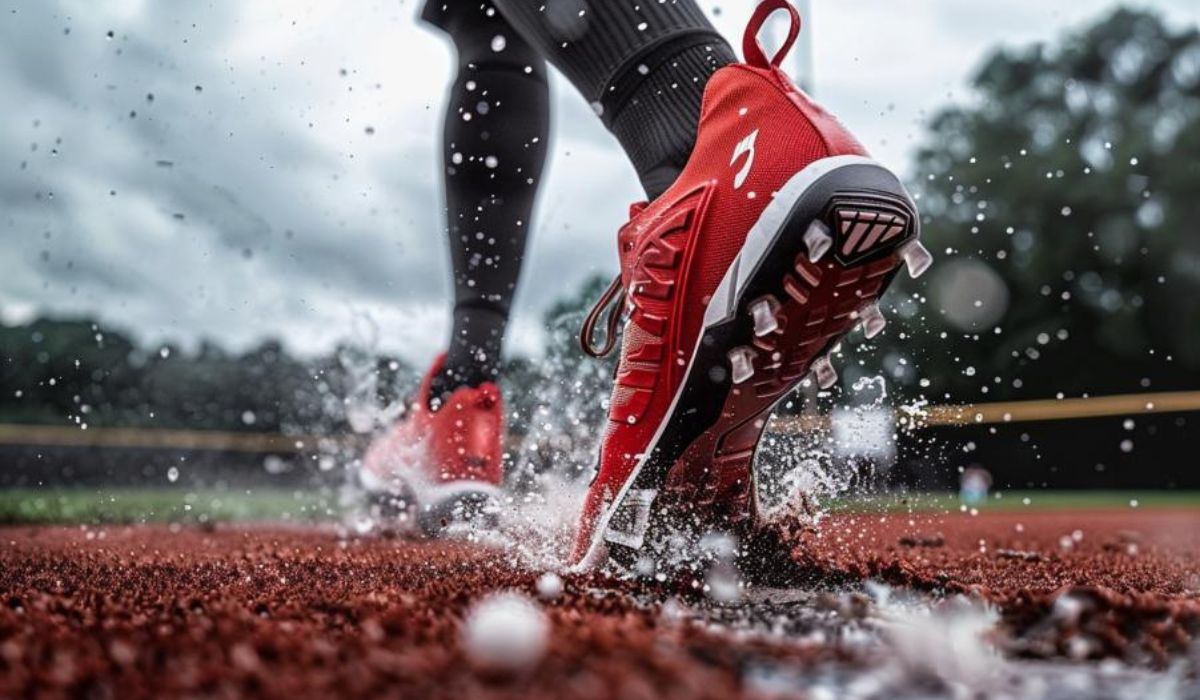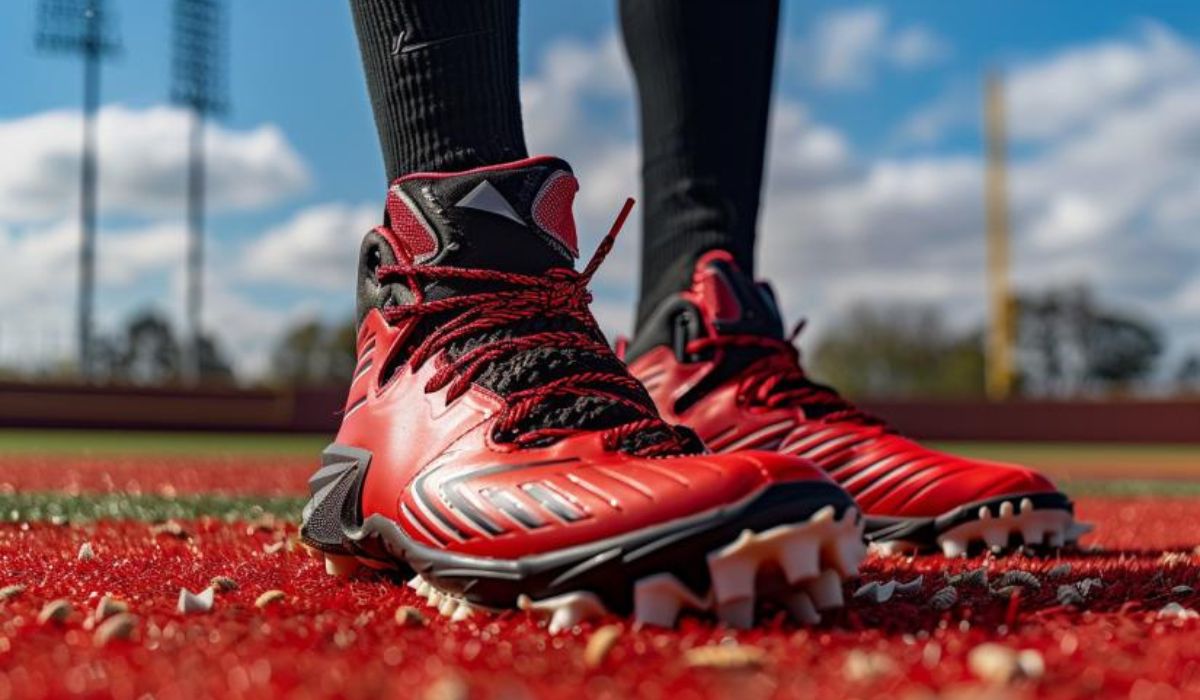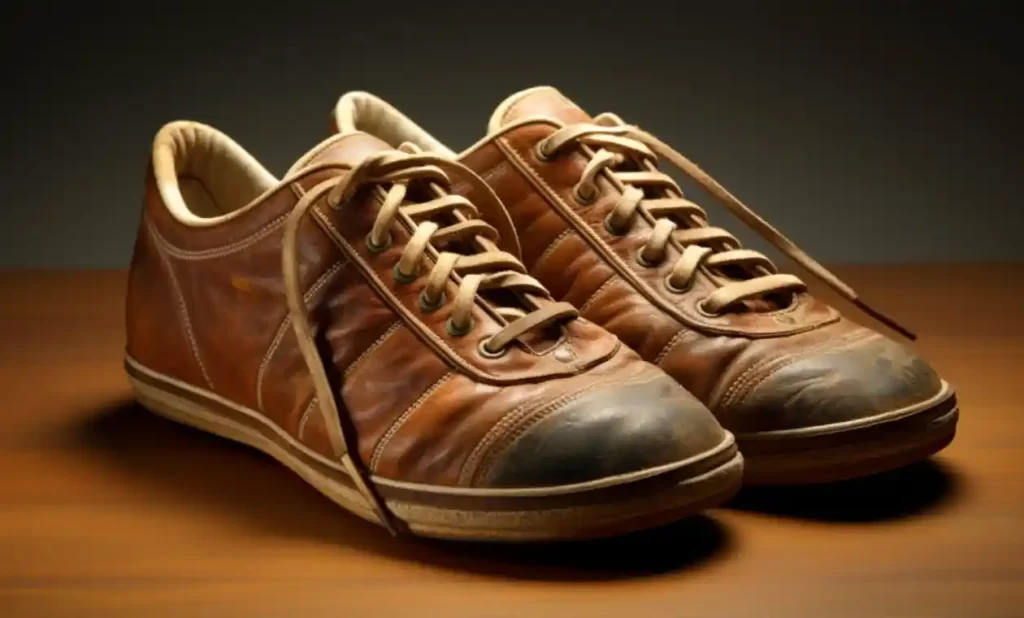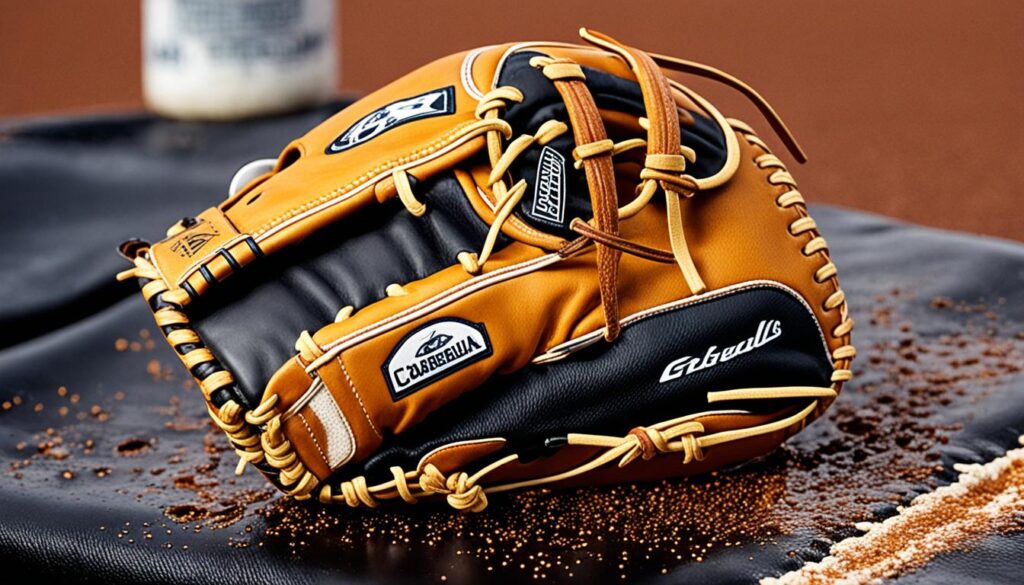
Being a baseball player means you get to experience the excitement of the game first hand. There is nothing like the thrill of being on the field. Each player has a special role and a part in the team’s success. To play well, you must have the right cleats on your feet.
The choice of cleat height is very important. Each type, whether low, mid, or high-cut, serves a different need. It’s key to pick the one that matches how you play and your position. So, let’s explore what each type offers and how they can improve your game.
Key Takeaways:
- Choosing the right cut length for your baseball cleats is crucial for performance and comfort.
- Low-cut cleats are lightweight, ideal for speed and agility, but offer less ankle support.
- Mid-cut and high-cut cleats provide more stability and ankle support.
- Consider your playing position, personal preference, and style of play when selecting the right cleats.
- Other factors like upper material, sole construction, lacing, and fit should also be taken into account.
Understanding Baseball Cleat Components
Baseball cleats are more than just shoes. They are specially designed for the game. Each part helps keep players comfortable, supported, and steady on the field.
The Upper
The upper part of a cleat is its outer section. It’s crafted from strong materials like synthetic leather or breathable mesh. This part keeps the foot stable and safe during quick or side-to-side moves.
The upper of a baseball cleat is crafted from durable materials to offer stability and protection during gameplay.
Some cleats also have a padded collar for comfort and a heel counter for more ankle support. This is common in low-top style cleats.
The Toe Cap
The toe cap helps protect the front of the foot. It’s there to keep toes safe during hard plays, like when sliding or pivoting.
The toe cap of a baseball cleat protects the toes from impact during intense gameplay.
The Outsole and Studs
The part of the cleat that touches the ground is called the outsole. It has a design that grips well on grass, dirt, and turf. Studs on the outsole are placed to give the best traction and avoid slipping.
The outsole and studs on a baseball cleat ensure optimal traction and stability on the field.
The Midsole and Insole
The cleat’s midsole and insole are inside. The midsole dampens shock, making high-impact moves easier on your feet and legs. The insole adds comfort and support, making the cleat feel better to wear.
The midsole and insole work together to provide shock absorption and cushioning, enhancing comfort and reducing fatigue.
Lacing and Tongue Flap
Cleat lacing is crucial for a good fit and to avoid slipping. Many cleats have a tongue flap too. It helps lower discomfort from tight laces.
The lacing system and tongue flap of a baseball cleat provide a secure fit while minimizing pressure and discomfort.
It’s key to know the parts of a baseball cleat to pick the right one. Next, we’ll look into the varied styles and materials of cleats.
| Component | Description |
|---|---|
| Upper | The outer part of the cleat, usually made of synthetic leather or breathable mesh. |
| Toe Cap | A protective feature for the front of the foot. |
| Outsole and Studs | The part of the cleat that touches the ground, with studs providing traction. |
| Midsole | Provides shock absorption and reduces impact on the feet and legs. |
| Insole | Offers cushioning and support for added comfort. |
| Lacing | Secures the cleat on the foot, providing a snug fit. |
| Tongue Flap | Reduces pressure and discomfort caused by the laces. |
Baseball Cleat Styles and Materials

When shopping for baseball cleats, it’s key to know the various styles and materials. Cleats are mostly a mix of mesh and synthetic leather. Each type brings special advantages for players.
Mesh is great for letting air flow, keeping your feet fresh during games. Its lightness helps players run faster and easier. This is perfect for those summer games when it’s really hot.
Synthetic leather is tough and lasts a long time. It gives good support for fast feet moves. Plus, these cleats are easy to keep clean, which is handy for those who play a lot.
There are many cleat styles to think about too. Some liked choices include:
- Molded Cleats: These have studs that are part of the sole. They’re great for grass.
- Metal Cleats: Pros like these for their excellent grip. They suit natural fields best.
- Turf Cleats: These are just for fake grass. They have many small, soft studs.
- Interchangeable Cleats: You can change the studs. This lets you play on different fields.
Which cleats are right for you? Consider where you play, what you like, and league rules. Knowing what’s out there helps you pick the best cleats for your game.
Considerations for Baseball Cleat Height
Choosing the right baseball cleat means thinking about the cleat’s height. You can pick from low-top, mid-top, and high-top styles. Each style has its own benefits.
Low-Top Cleats
Low-top cleats are light and flexible. They’re good for players who want to be fast and move easily. But, they don’t give as much support to the ankles. They work best for those who don’t need a lot of ankle support.
Mid-Top Cleats
Mid-top cleats offer both agility and some ankle support. They cover the ankle a bit more than low-tops. They are good for players who need a balance of support and movement.
High-Top Cleats
High-top cleats give the most ankle support. They have a collar that goes up the ankle. This helps protect against injuries. They are great for players who need a lot of ankle support, like those who have been injured before.
The right cleat height is mostly up to you and how you play. Low-tops might be great for speed. Mid or high-tops might be better if you need more support. Finding what’s best for you is key for doing your best on the field.
When picking cleats, also look at the material, fit, and how well they grip the ground. This ensures you get both comfy and useful cleats. Next, let’s look at how baseball cleats are made and what parts they have.
Baseball Cleats for Different Positions
Choosing the right baseball cleats matters a lot depending on your position. Outfielders, infielders, and pitchers might look for different things in cleats. What they need is based on what they do on the field.
Outfielders need to cover a lot of distance quickly. They look for cleats with good grip for starting and stopping fast. Many outfielders like metal cleats for the best grip on grass and dirt. These cleats help them run after fly balls and throw them back accurately.
Infielders move a lot from side to side and need to be quick. They often choose molded cleats. Molded cleats are light and provide good grip on the field. This helps infielders move fast and make plays accurately.
Pitchers need to be both quick and supported. Their top choice is often low-top cleats. Low-top cleats are light and allow for easy movement. They keep pitchers’ ankles safe and make sure they stay nimble on the mound.
Your personal style and what you need for your position guide the cleat choice. It’s about picking cleats that balance comfort, support, and performance for you.
| Position | Recommended Cleat Type |
|---|---|
| Outfielders | Metal Cleats |
| Infielders | Molded Cleats |
| Pitchers | Low-Top Cleats |
Finding the Right Fit for Baseball Cleats
Choosing the perfect baseball cleats is crucial. The right fit means better performance and comfort. It offers stability during quick moves and avoids blisters. Here’s what to consider when picking the right size:
- Try Them On: It is crucial to try on baseball cleats before making a purchase. Sizes may vary between brands, and trying them on allows you to assess the fit and comfort.
- Room in the Toe: Cleats should have some room in the toe area, allowing for natural movement and preventing discomfort during extended play.
- Athletic Socks: Wear athletic socks when trying on cleats to simulate actual game conditions. This ensures that the fit accommodates the additional padding and thickness provided by the socks.
When you get cleats that fit right, you’ll play better and focus on the game. Finding the perfect fit is crucial for your performance on the baseball field.
| Sizing Criteria | Recommended Fit |
|---|---|
| Toes | There should be room to wiggle your toes. Small cleats can hurt and limit movement. |
| Width | Cleats must fit comfortably but not be too tight. They have to balance snugness with movement. |
| Arch Support | The cleats must support your arches, preventing tired, sore feet during long games. |
| Heel Fit | Heels should not slip or rub. A firm heel grip means stability during fast moves. |
Tips for Ensuring the Right Fit:
- Measure Feet: Before looking for cleats, measure your feet accurately to start off right.
- Shop in the Afternoon: Cleat shopping in the afternoon matches the natural swelling of your feet.
- Bring Athletic Socks: Using the right socks while fitting helps find the perfect cleat fit.
- Walk and Move Around: Don’t just stand in cleats. Walk and move to check their comfort in action.
Important Factors When Choosing Baseball Cleats
When picking baseball cleats, think about the material, stud length, and a reinforced toe. These things can really help your game. The right cleats will keep you steady and comfortable on the field.
Cleat Material
Cleat material is key for performance and longevity. Leather cleats have a classic touch and are comfy. On the other hand, synthetic materials are water-resistant, perfect for damp grounds. The choice between materials affects your game and comfort level.
Stud Length
Consider the stud length of your cleats too. The studs affect how you grip the ground, especially on different surfaces. Select longer studs for softer fields and shorter ones for turf. By picking the right stud length, you can prevent slipping and play your best.
Toe Drag Considerations
For players who drag their toes, the cleat’s toe design is critical. This habit can wear down the shoe’s front quickly. Choose cleats with a reinforced toe to last longer. These cleats can take the extra wear and keep you performing well all season.
| Cleat Factors | Material | Stud Length | Toe Drag |
|---|---|---|---|
| Impact | Leather or Synthetic | Varied lengths for different field conditions | Reinforced toe for durability |
| Benefits | Combination of comfort and water resistance | Improved traction and stability | Extended lifespan for players with toe drag |
| Considerations | Personal preference and playing style | Field conditions and playing surface | Pitching technique and tendency for toe drag |
Differences Between Baseball/Softball Cleats and Other Sport Cleats
Different sports need different shoes to play well and stay safe. Baseball and softball cleats help players perform better on the field. Here, we’ll look at how they’re different from cleats used in football and soccer.
Baseball/Softball Cleat Pattern
Baseball and softball cleats have a special design for the field. They use metal or rubber studs placed for the best grip without hurting the grass.
Soccer cleats, though, have many small studs that help players move quickly and stay balanced on grass or turf.
Football cleats have longer studs for strong grip and stability while sprinting and making fast turns.
Sport-Specific Cleats
Baseball and softball cleats focus on supporting the foot and ankle. They protect players during the intense movements of the game. These cleats have extra toe protection too.
Football cleats are more about staying stable and safe during rough play. They are heavier and provide stronger support for the foot and ankle.
Soccer cleats are light. They are designed for quick foot movements and precise control of the ball. They don’t have a toe spike to avoid injury.
“Choosing the right pair of cleats is crucial for optimal performance and safety in any sport.”
– Baseball Pro
Incompatibility of Cleats
It’s important not to use cleats from one sport in another. This is because each sport’s cleats are made for the game’s specific needs and safety.
Using the wrong cleats can lead to slipping, falling, and getting hurt. Cleats from football or soccer are not good for baseball or softball either. They don’t support movement well on the field.
| Baseball/Softball Cleats | Football Cleats | Soccer Cleats |
|---|---|---|
| Designed for running, sliding, and base-running | Provides stability for fast sprints and lateral movements | Optimizes agility, speed, and ball control |
| Specific cleat pattern for optimal traction on grass | Aggressive pattern with detachable studs | Patterned for various ground types, including grass and turf |
| Offers ankle support and reinforced toe caps | Prioritizes stability and impact absorption | Lightweight and streamlined for agility and ball control |
It’s crucial to pick the right cleats for each sport for the best performance and safety.
Tips for Sizing and Buying Baseball Cleats
Sizing and buying baseball cleats is important. The right cleats help you perform better, stay comfortable, and avoid injuries. Here are some key tips to help you choose the best pair.
1. Size Similar to Regular Athletic Shoes: Choose baseball cleats that match your usual athletic shoes in size. If your feet are wide, opt for a larger size for better comfort.
2. Wear Athletic Socks: Always wear athletic socks when trying on cleats. These socks are thicker than regular ones. They ensure you get the right feel and fit while trying them on.
3. Snug Fit: Cleats should be snug, not too loose or tight. A snug fit offers support and stability when you move quickly. But, make sure there’s some room at the toes to move freely and avoid blisters.
4. Age and Level of Play: Your age and how serious you are about baseball matter when buying cleats. For younger or recreational players, basic cleats could be fine. But, experienced players might want to invest in high-quality, durable cleats for better performance.
Finding the perfect baseball cleats is key for playing your best and enjoying the game. Take your time to test out various styles, sizes, and brands in store. This ensures you get the pair that fits you just right. Enjoy shopping!
Conclusion
When picking baseball cleats, there’s plenty to think about. Think about the cut, the materials used, their height, and where you play. Your comfort and preference are also very important. By looking at these aspects, you make sure your cleats boost your game and keep you comfortable.
Good cleats are key in baseball for better playing and comfort. The right pair will give you all the support and tools you need to be your best. If you need to be fast, low-cut cleats might be best. Or, if you need more support, you might prefer mid-cut or high-cut cleats.
Finding the right fit is crucial when selecting cleats. A tight fit with enough toe room can cut down on blisters and offer support during quick steps. Always try the cleats on with sports socks to check the fit. Also, think about how durable the cleats need to be, especially if you pitch and drag your toes often.
Recommended
- METAL VS MOLDED BASEBALL CLEATS: CHOOSE RIGHT
- CHOOSING THE RIGHT BASEBALL CLEATS: LOW VS. MID VS. HIGH CUT

Meet Daniel Anderson, the heart and soul behind Baseball Pro Picks. At 49, Daniel’s life has revolved around baseball, a passion that’s as strong today as it was when he first fell in love with the game. Living in the USA, Daniel has dedicated countless hours to watching, analyzing, and understanding every pitch, hit, and home run, making almost no game missed. His deep-rooted love for the sport is matched only by his commitment to sharing insightful, expert analysis with fellow baseball enthusiasts. With decades of experience and a keen eye for the game’s nuances, Daniel brings a unique perspective that enriches Baseball Pro Picks. Trust Daniel to guide you through the intricacies of baseball with the authority and trustworthiness of a true aficionado.












